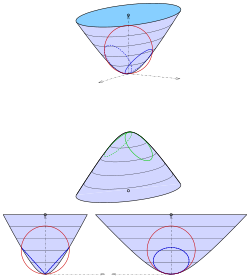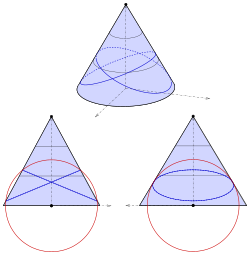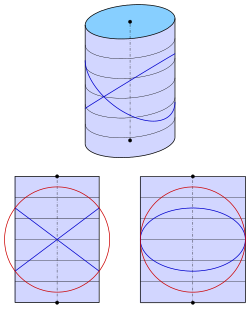
3-axis ellipsoid with a circle as a plane section
A circuit section plane is in the geometry of a plane (in 3-dimensional space) which is a quadric ( ellipsoid , hyperboloid , ...) in a circle intersect. A sphere is cut in a circle by every plane with which it has at least 2 points in common. The position is also simple for rotational quadrics (rotational ellipsoid, hyperboloid, paraboloid, cylinder, ...): They are cut in circles by all planes that are perpendicular to the axis of rotation, if they have at least 2 points in common. The position of 3-axis ellipsoids, genuinely elliptical hyperboloids, paraboloids, cylinders, ... is no longer obvious , although there are even more intersection circles in these asymmetrical cases. The following applies:
- Every quadric (area in 3-dimensional space) that contains ellipses also contains circles (see below).
Quadrics that are not included are: 1) parabolic cylinder , 2) hyperbolic cylinder, and 3) hyperbolic paraboloid . A comprehensive discussion of all cases is e.g. B. in the book by Grotemeyer (see literature ) included.
Circular sections of quadrics were previously used to create models (see #Weblinks ).
Circular sectional planes also play a role in crystallography .
Description of the method
To find the planes that intersect a quadric in a circle, two essential observations are used:
-
(K :) If the intersection of a quadric with a sphere (auxiliary sphere ) lies in a pair of planes (two intersecting planes), the intersection consists of two circles.
-
(P :) If a plane intersects a quadric in a circle, this is also the case for all planes parallel to it , which have at least two points in common with the quadric.
To find circles on a quadric, it is sufficient to find an auxiliary sphere that intersects the quadric in a pair of planes. Then the planes parallel to the planes provide two sets of intersection circles.

3-axis ellipsoid with circular cuts (blue and green) and the auxiliary sphere (red) that cuts the ellipsoid in the blue circles

Figure 1: Ellipsoid cut with spheres:

3-axis ellipsoid
For the ellipsoid with the equation

and the semi-axes one uses an auxiliary sphere with the equation


The sphere radius must now be determined in such a way that the intersection of the ellipsoid and the sphere lies in a pair of planes through the origin . So that the absolute term falls out, one subtracts the spherical equation from the factor of the ellipsoid equation. It turns out


This equation describes a pair of planes only if one of the three coefficients is zero. Both for and for there are equations that are only satisfied by points on the -axis or -axis. Only the case leads to a pair of planes with the equation






because only in this case do the remaining coefficients have different signs (because of ).

Figure 1 shows how the cuts with unsuitable spheres look like: The radius is too large (magenta) or too small (cyan).
If the values of the semi-axes and approach, the two sets of circles also approach. For (ellipsoid of revolution) all circular planes are orthogonal to the axis of rotation.



Proof of property (P):
If the ellipsoid is rotated around the -axis so that one of the two blue circles lies in the -plane, the ellipsoid suffices for one equation



and for results . For this to be a circular equation, it must be true. If one now cuts the ellipsoid with a plane parallel to the plane with the equation , the result is





-
 .
.
This equation describes a circle or a point or the empty set. (The center and radius are obtained after completing the square .)
Elliptical single-shell hyperboloid
For the hyperboloid with the equation

one obtains (as with the ellipsoid) the equation
for the intersection with a sphere

This results in a pair of levels only for :


Elliptical cylinder
For the elliptical cylinder with the equation

one obtains the equation

There is a pair of levels only for :


Remarks:
- Since the above single-shell hyperboloid becomes the cylinder of this section, the circular planes of the cylinder result from those of the hyperboloid in this way.

- An elliptical cylinder can therefore always be understood as an oblique circular cylinder .
Elliptical paraboloid

Figure 2: Elliptical paraboloid
For the elliptical paraboloid with the equation

choose a sphere through the vertex with the center on the axis:

After eliminating the linear term, the equation results

There is a pair of levels only for :


Note:
The radius of the sphere is equal to the radius of the curvature of the further parabola (see Figure 2).
Elliptical double-shell hyperboloid

Figure 3: Elliptical double-shell hyperboloid
The double-shell hyperboloid with the equation

it is advisable to move it so that a vertex is the origin (see Figure 3):

The sphere is also chosen in such a way that it contains the origin and its center point lies on the axis:


After eliminating the linear term, the equation results

There is a pair of levels only for :


Note:
The radius of the sphere is equal to the radius of the circle of curvature of the further hyperbola (see Figure 3).
Elliptical cone

Figure 4: Elliptical cone
The elliptical cone with the equation

it is advisable to move it so that its tip is not at the origin (see Figure 4):

Now you can use a sphere around the origin:

The elimination of results in:


Since planes are to be expected that do not go through the origin, one carries out a quadratic addition and obtains:

For this equation to describe a pair of planes, the right-hand side must be zero; H.
If you then dissolve, you get:



Note:
An elliptical cone can always be understood as an oblique circular cone . One should note, however, that the straight line through the apex and the center of the circle is not the axis of the cone (axis of symmetry).
literature
-
KP Grotemeyer : Analytical Geometry. Göschen-Verlag, 1962, p. 143.
- H. Scheid, W. Schwarz: Elements of linear algebra and analysis. Spektrum, Heidelberg, 2009, ISBN 978-3-8274-1971-2 , p. 132.
Individual evidence
-
^ WH Westphal: Physical Dictionary: Two parts in one volume. Springer-Verlag, 1952, ISBN 978-3-662-12707-0 , p. 350.
-
↑ H. Tertsch: The strength phenomena of the crystals. Springer-Verlag, Vienna, 1949, ISBN 978-3-211-80120-8 , p. 87.
-
^ G. Masing: Textbook of general metal science. Springer-Verlag, Berlin, 1950, ISBN 978-3-642-52-993-1 , p. 355.
Web links

























































